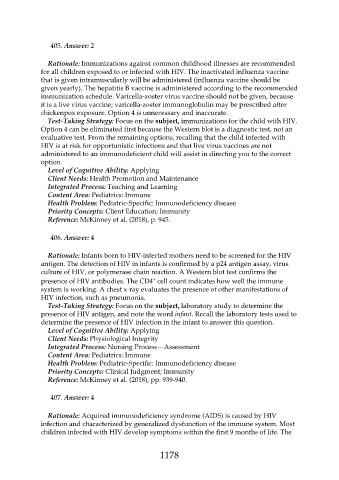Page 1178 - Saunders Comprehensive Review For NCLEX-RN
P. 1178
405. Answer: 2
Rationale: Immunizations against common childhood illnesses are recommended
for all children exposed to or infected with HIV. The inactivated influenza vaccine
that is given intramuscularly will be administered (influenza vaccine should be
given yearly). The hepatitis B vaccine is administered according to the recommended
immunization schedule. Varicella-zoster virus vaccine should not be given, because
it is a live virus vaccine; varicella-zoster immunoglobulin may be prescribed after
chickenpox exposure. Option 4 is unnecessary and inaccurate.
Test-Taking Strategy: Focus on the subject, immunizations for the child with HIV.
Option 4 can be eliminated first because the Western blot is a diagnostic test, not an
evaluative test. From the remaining options, recalling that the child infected with
HIV is at risk for opportunistic infections and that live virus vaccines are not
administered to an immunodeficient child will assist in directing you to the correct
option.
Level of Cognitive Ability: Applying
Client Needs: Health Promotion and Maintenance
Integrated Process: Teaching and Learning
Content Area: Pediatrics: Immune
Health Problem: Pediatric-Specific: Immunodeficiency disease
Priority Concepts: Client Education; Immunity
Reference: McKinney et al. (2018), p. 945.
406. Answer: 4
Rationale: Infants born to HIV-infected mothers need to be screened for the HIV
antigen. The detection of HIV in infants is confirmed by a p24 antigen assay, virus
culture of HIV, or polymerase chain reaction. A Western blot test confirms the
+
presence of HIV antibodies. The CD4 cell count indicates how well the immune
system is working. A chest x-ray evaluates the presence of other manifestations of
HIV infection, such as pneumonia.
Test-Taking Strategy: Focus on the subject, laboratory study to determine the
presence of HIV antigen, and note the word infant. Recall the laboratory tests used to
determine the presence of HIV infection in the infant to answer this question.
Level of Cognitive Ability: Applying
Client Needs: Physiological Integrity
Integrated Process: Nursing Process—Assessment
Content Area: Pediatrics: Immune
Health Problem: Pediatric-Specific: Immunodeficiency disease
Priority Concepts: Clinical Judgment; Immunity
Reference: McKinney et al. (2018), pp. 939-940.
407. Answer: 4
Rationale: Acquired immunodeficiency syndrome (AIDS) is caused by HIV
infection and characterized by generalized dysfunction of the immune system. Most
children infected with HIV develop symptoms within the first 9 months of life. The
1178

